Two-minute bite-sized chunk provides the answer.
Two-minute bite-sized chunk provides the answer.
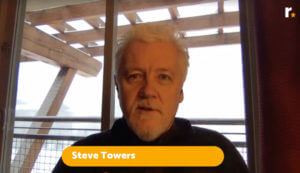
This was an interview across the continents
(I am currently in Colorado, James is in England)
https://www.facebook.com/JDODKINS/videos/1425739797553815/
Do get along to the link – James will be hosting CX Rockstars from all over the globe 🙂

https://itunes.apple.com/za/podcast/futurology/id1078860959?mt=2&i=1000397468049
You can reach Roland here to progress the discussion:
https://www.linkedin.com/in/roland-naidoo-b403a029/
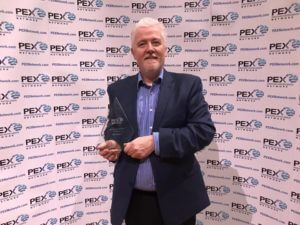 I was deeply honoured by the PEX community at the annual conference in Florida last month and received the Global Community 2018 Award. Needless to say (but I will) this is as much down to you guys and your great transformational work, so I graciously excepted the Award on your behalf. Thank you so much :
I was deeply honoured by the PEX community at the annual conference in Florida last month and received the Global Community 2018 Award. Needless to say (but I will) this is as much down to you guys and your great transformational work, so I graciously excepted the Award on your behalf. Thank you so much :
See the snapshot here: https://buff.ly/2EEE9Im
Next time we will be reviewing highlights of the upcoming 2018 conferences…
Outside-In is a regular theme during most of my keynotes, not least this last week here in Florida. A question asked from the floor related to the 30-second elevator test “can you explain to the CEO what this stuff is, why it is 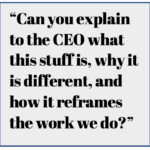 different, and how it reframes the work we do?”. I guess I was about to fudge and say this needs more than 30 seconds, and then remembered my two-slide explanation!
different, and how it reframes the work we do?”. I guess I was about to fudge and say this needs more than 30 seconds, and then remembered my two-slide explanation!
So, for those guys looking for a simple explanation, these two slides will do the job. I have put a bit of narrative in there also.
120+ in Florida at the keynote, 16 January 2018
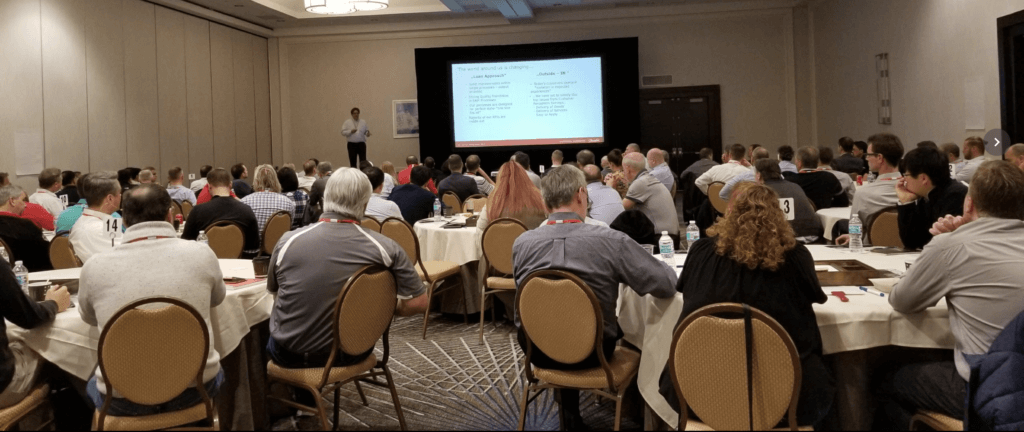
The old, industrial-age traditional way of doing business.
We make products (and services). We look for the market to sell them in. We segment customers by circumstance and pitch our products to those segments. We add variations to the products to better fit certain niche segments. We build back-end systems and digital capabilities in this increasingly complex world. We are rigid, functionally oriented and abhor change.
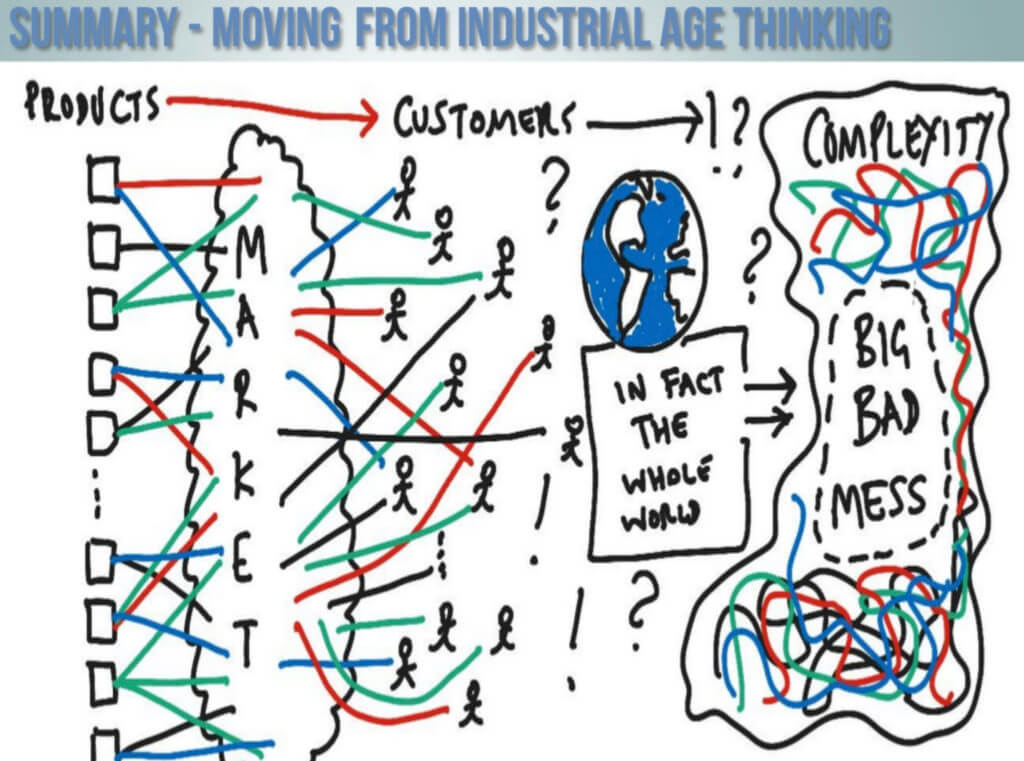
The new Outside-In customer-centric way.
We identify the customers we would like to do business with. We understand their needs (even when they may not know them themselves) and specific Successful Customer Outcomes (SCO’s).
We categorise customers by need. We then create the capability to deliver to these categories the SCO’s (both products, people and digital). Progressively we manage new and existing customer expectations to deliver success without exception. We are agile, innovative and attuned to 21st century needs.
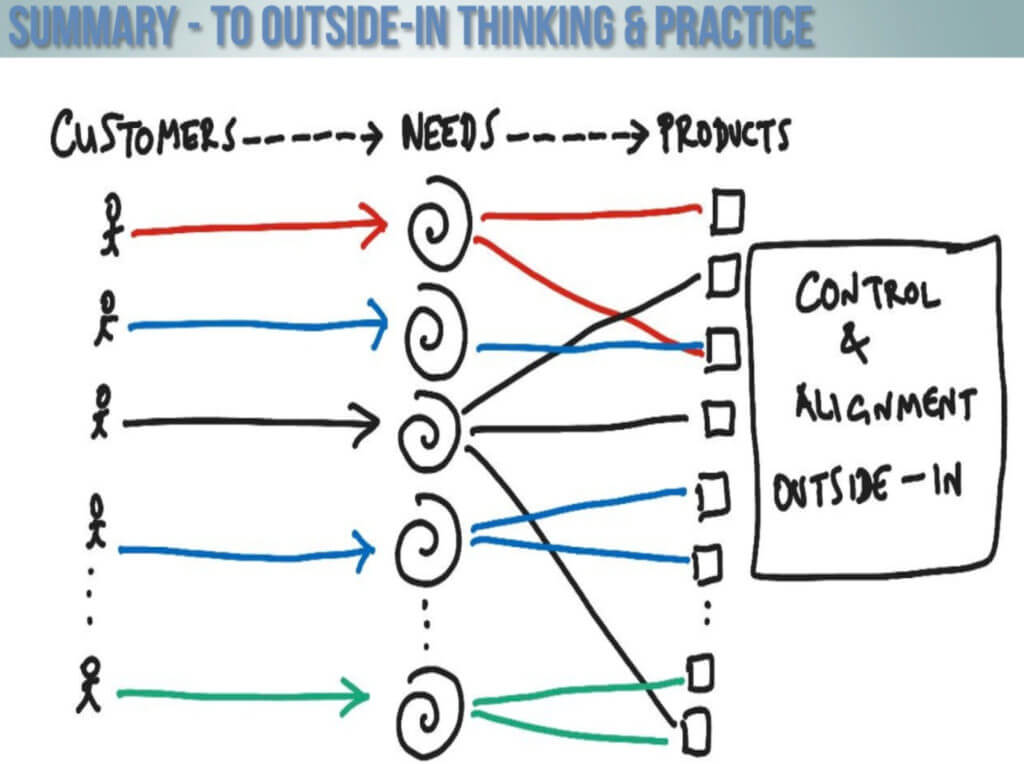
Let me know if this works for you.
Ciao, Steve
For the curious, the original slides came from a deck presented as a keynote in Sydney, Australia 3 years ago.
You can access that here: http://bit.ly/SydneyPEX
1. Design digital experiences around the customer needs, not around your customer mythology
Despite mountains of data customer insight remains an elusive animal. As a direct consequence, digital is frequently applied across existing processes without fully understanding customer pain points and the real Successful Customer Outcome.
Making invalid assumptions can irritate and permanently drive customers away. Take grocery checkout for example where retailers digitize an existing experience based on assumptions of customers wants. The resulting experience may still be fractured, with faulty scanners (they break a lot), long lines, and the more than necessary Associates to provide support for glitches. Not a great customer experience. If, however you develop an understanding of customer needs (even when customers do not know them) you may discover the checkout process is not required at all. Eradicating that process meets customer’s desires in terms of speed, convenience, and simplicity.
Amazons (i) checkout-less retail stores, walk in walk out enabled by scanning your phone on entry, scanning goods as you move around the store, and then scanning your phone on departure with automatic billing, provides just such an experience. In addition to improving the experience, costs are reduced and the customers come back for more and thereby grow revenues. In fact, this triple-crown benefit is a sure fire way of measuring any customer experience transformation.
2. Drive digital initiatives to simplify and improve convenience
Customer Research demonstrates the disconnect between what executives think customers value in digital, compared to working out their needs in a more objective and structured way. A technique such as the Successful Customer Outcome Canvas (SCOC)(ii) provides a step by step approach to articulating actual needs and aligning the experiences to deliver them. The resulting insight in terms of a set of objective measures based on needs allows the organization to question every interaction in the context of ‘does this contribute to the SCO?’ and if not, how do we remove it?
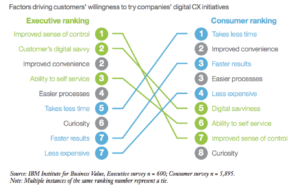
Uber(iii) are a terrific example of ‘one click simple’ with the apps user interface designed around understanding the overall Successful Customer Outcome and then delivering an optimum number of interactions. Providing this digital experience helps meet the customer’s desire to move efficiently, pay digitally, and provide feedback in the moment. Part of that ‘Successful Customer Outcome Canvas’ insight was in removing the anxiety of where is the car and how long do I wait? You can see the car and driver speeding towards you on the app.
3. Categorize your customers by need, rather than segmenting by circumstance.
Dealing with customers as segments (age, income, zip code etc.) misses the vital personalisation that digital excels at. By force fitting customers into standardized processes suited to segments creates friction and fractured experiences. Diagnosing objective needs may, for instance, highlight the digital savviness (or not) of a category of customer, and in doing so allow you to create a bespoke experience. Rather than industrial age segmentation, organizations that adopt Outside-In(iv) categorization meet and evolve customer expectations in an informed way with greater empathy and the resulting trust that “you have my back”.
Are you ready? Ask yourself these questions (be honest and not complacent!)
a. Are digital initiatives aligned to Successful Customer Outcomes with optimized touch points, or are they designed around internal functional considerations?
b. Is your approach to innovation Outside-In and not restricted to departments, internal specialisms, legacy systems, regulations and last century mindsets?
c. Are you tapping in-the-moment real-time analytics to understand what your customers are experiencing as it happens, and then course correcting those experiences as they occur?
d. How are you managing your customer’s digital expectations? Are you keeping them informed of developing digital services?
e. What mechanism are you using to incorporate new digital learnings into the customer experiences? And are those learnings (next practices) gathered from outside of your sector, or are they just industry best practices?
References
i. http://bit.ly/goCX2017
ii. http://bit.ly/SCOC2017
iii. http://bit.ly/Uber2017
iv. http://bit.ly/SteveTowers2017
|
Best Practice Tip: As you name your breakpoints try using the syntax – do something, to something to get something. An example might be
“open the email to action the request” |
Note – This may initially present a challenge as it is not something we commonly have done in the past. Persevere and do your best to identify the Break Points in your target area and enough information will be available for you to build your cost reduction plan.
 This wouldn’t have been possible if you don’t think outside in…..if you don’t make the process for the experience of the customers and not just for your capabilities. Many I talk to think the innovation is a gamble…..how frustrating when actually innovation can be achieved by looking at a process and thinking of creating an ecosystem with others to achieve that. But anyway, happy that I can relate to these innovations and think it’s just how you look at your processes and not some design room magic by einstein haired scientists. Thanks for the halo.
This wouldn’t have been possible if you don’t think outside in…..if you don’t make the process for the experience of the customers and not just for your capabilities. Many I talk to think the innovation is a gamble…..how frustrating when actually innovation can be achieved by looking at a process and thinking of creating an ecosystem with others to achieve that. But anyway, happy that I can relate to these innovations and think it’s just how you look at your processes and not some design room magic by einstein haired scientists. Thanks for the halo.Over the following weeks we will delve into each area and I will provide examples and case studies of each aspect of this Copernican shift.
| The Focus has shifted from Inside-Out to Outside-In | |||
| Industrial/Information Age | Customer Age | ||
| People | Silo’s | Multi functional | |
| Specialist | Multi skilled | ||
| Isolated | Relationships | ||
| Awards – Time served | Awards – Value Created | ||
| Autocratic | Dynamic (to suit the needs) | ||
| Processes | Doing things right | Doing the right things and doing things right | |
| Manufacturing mindset | Customer Experience | ||
| Tasks/Activities and Outputs | Outcomes and SCO’s | ||
| Stocks | Flows | ||
| Products | Services | ||
| Left to Right, Top to Bottom | Customer Centric | ||
| IT | Algorithmic | Heuristic | |
| Hierarchical | Hyperlinked | ||
| Analytical | Understanding | ||
| Ownership | Access | ||
| Strategy | Top Down | Inclusive | |
| Structured and Rigid eg 5 yr plans | Agile and Adaptive | ||
| Tablets of stone | Continual Alignment to SCO’s | ||
| Market/product focus | Customer/expectation focus | ||
| Customers | Uninformed | Prosumer | |
| Loyal | Promiscuous | ||
| Forgiving | Rebellious | ||
| Locked-In | Demand Flexibility | ||
| Compliant and managed | High Expectations and fickle | ||
| Single channel | Multi channel | ||
| (c) 2012 Steve Towers | |||
Next week we’ll start by reviewing the Customer Aspect
Join us at the CPP Master Class London http://londonmasters2012-estw.eventbrite.com
(let’s acknowldge a great spot by Samir Asaf CPP Master)